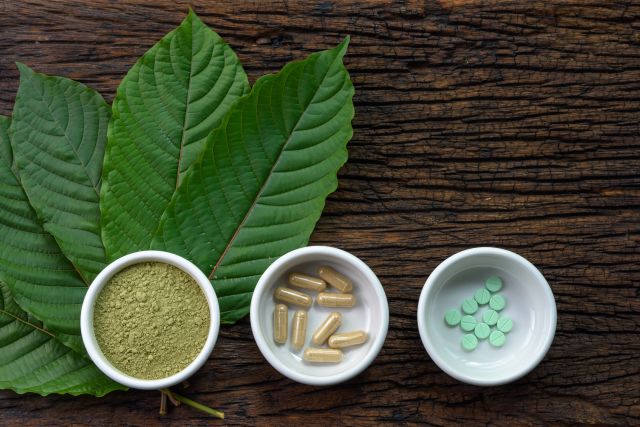Updated on October 23, 2024.
While it might not be on everyone’s radar, kratom is on the rise. About 1.7 million people in the United States aged 12 or older used the herbal supplement in 2021, either recreationally or to self-manage medical conditions such as pain or insomnia. Fans of kratom argue it helps them feel better, has few drawbacks and—thanks to its online presence—is easier to obtain than prescription medication.
But kratom’s increasing popularity hasn’t come without problems. Critics have serious concerns about kratom’s safety, for good reason. As many as 20 percent of people who use kratom in the United States have reported having symptoms that are likely signs of kratom use disorder. Calls to poison centers about kratom exposure have also been on the rise.
One study found that of the 1,807 calls to U.S. poison control centers about kratom between 2011–2017, two-thirds of these happened in 2016-17, marking a big rise in use. Another report looked at calls to the Wisconsin state poison center between 2010 and 2022. Researchers found that in the period between 2016–2020, calls about kratom exposure nearly quadrupled.
Skeptics also say there’s little scientific proof kratom actually works. “There are no large, randomized clinical trials out there that have statistically proven its benefit in adults,” says Kinjal Desai, MD, MPH, clinical assistant professor in the department of neurology and ophthalmology at Michigan Medicine. Kratom is not prescribed by healthcare providers (HCPs) or approved by the U.S. Food and Drug Administration (FDA) as a medical treatment.
In fact, the FDA warns it shouldn’t be used at all, and it’s illegal to sell kratom as a medical treatment. The FDA has also ruled that kratom can’t be legally marketed as a supplement, and it can’t be added to regular foods.
So, what’s the big deal about kratom? Here’s what you should know about the reasons people take it, how it works—and why it might be hazardous to your health.
What is kratom?
Kratom (pronounced KRAY-tem) comes from Mitragyna speciosa, a tree commonly found in Southeast Asian countries like Malaysia, Thailand, and Myanmar. M. speciosa leaves can be chewed whole, made into a liquid extract, or turned into powder, capsules, or tablets. Many users brew tea with kratom, and there’s even kratom gum. Among other names, kratom may also be called biak, kakuam, ketum, thang (ithang), and thom.
The main active ingredients in kratom are a pair of compounds called mitragynine and 7-hydroxymitragynine, which influence the same parts of the brain as opioids. Once ingested, kratom typically takes a few minutes to kick in, and may continue working for several hours. “Depending on how much you consume,” says Dr. Desai, “kratom may have different types of effects.”
In small amounts, kratom stimulates the central nervous system. “There’s an increased amount of energy, making you more sociable and more interactive,” Desai explains. For this reason, kratom is sometimes used recreationally and is known to make the rounds at music festivals.
In larger amounts, kratom may lessen pain, induce a high, and eventually “cause a sleepiness or sedation,” Desai says. Owing to these effects, people use it to treat health problems such as muscle pain, panic attacks, diarrhea, menstrual cramps, and PTSD.
Kratom is also said to reduce cravings and is advertised as an appetite suppressant. Many have reported taking it to wean themselves off opioids or alcohol, as well.
Though it’s legal on a federal level, as of November 2023, the active ingredients in kratom have been declared unlawful in six U.S. states and banned in some cities and counties, which consider it to be a Schedule 1 substance like heroin or cocaine. It is against the law to advertise the herbal supplement as a medical treatment, and several companies have been fined heavily by the FDA for doing so. Despite these obstacles, kratom remains easy to come by. While it’s not available in major drugstores or supermarkets, you can find it online and at smaller establishments in areas that permit its use.
What are the downsides of kratom?
Desai compares the support for kratom to that of marijuana and some other herbal supplements. Enthusiasts find it works for them, and since it comes from a plant, they believe it’s safe to use. The problem is, there’s no hard scientific evidence kratom successfully treats any medical condition—and perhaps more alarming, there are significant worries about its safety.
For one thing, kratom has multiple potential side effects, says Desai, and people who take high doses or take it for a long time may have an increased risk. Possible mild side effects include dizziness, drowsiness, constipation, and nausea.
Kratom could also react with medications, causing serious headaches or communication problems. The substance has been found in newborn and nursing babies, as well, which means it may be passed from parent to child through the placenta or breast milk. There have been reports of withdrawal symptoms in infants.
Sometimes, kratom use may lead to severe breathing issues, vomiting, high blood pressure, liver damage, confusion, tremors, seizures, coma, and death. It’s unknown exactly how much kratom is toxic; it likely differs by person, formulation, ingested dose, length of time used, and the amount of active ingredient.
Kratom overdose fatalities are not consistently tracked on a national basis. However, between July 2016 and December 2017, it played a role in at least 91 overdose fatalities, according to the Centers for Disease Control and Prevention. Additional drugs—usually fentanyl—were involved in the vast majority of these deaths, though some people had apparently taken kratom by itself. In December 2023, a Tampa Bay Times investigation found that in the decade prior, 580 people had died from overdoses that involved kratom, 46 of which involved only kratom and no other substances.
The potential for addiction is another major downside to kratom. Even though it’s taken by some to help come off opioids, there are concerns about dependence. Users may not know how much to use, or they may need increasingly more kratom for the same high. Or, they can have withdrawal-like symptoms after they quit, including muscle pain, diarrhea, runny nose, depressed mood, anxiety, and lethargy.
Finally, since kratom is considered a “dietary ingredient” by the FDA, it’s not regulated like medication. This increases the risk of contamination. In 2018, at least 199 people in the United States became sick after taking kratom tainted with salmonella bacteria.
It also means the quantity of active ingredient may differ from what’s printed on the label, or that there could be additional, potentially dangerous substances mixed in, such as heavy metals, which may be harmful with long-term exposure.
The bottom line
While there is some anecdotal evidence of kratom’s benefits, they’re largely outweighed by its considerable drawbacks. Studies proving kratom’s efficacy and long-term safety would help bolster its case, says Desai, but “I don't think it should be something that should be consumed, professionally speaking.”
In the meantime, it’s best to speak with your HCP about therapies for chronic pain, panic attacks, and other health conditions. Together, you can work to find treatments proven to be safe, effective, and right for you.







